The Knight in the Panther's Skin
The Knight in the Panther's Skin (Georgian: ვეფხისტყაოსანი, translit.: vepkhist'q'aosani pronounced [vɛpʰxist’q’ɑosɑni] literally "one with a skin of a tiger") is a Georgian medieval epic poem, written in the 12th century by Georgia's national poet Shota Rustaveli.[1] A definitive work of the Georgian Golden Age, the poem consists of over 1600 Rustavelian Quatrains and is considered to be a "masterpiece of the Georgian literature".[2] Until the early 20th century, a copy of this poem was part of the dowry of any bride.[3][4]
| ვეფხისტყაოსანი Vepkhistqaosani The Knight in the Panther's Skin | |
|---|---|
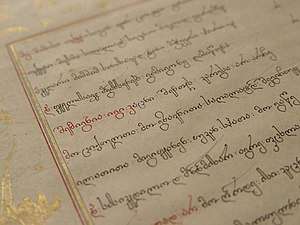 17th-century manuscript of Vepkhistqaosani | |
| Author(s) | Shota Rustaveli |
| Dedicated to | King Tamar of Georgia |
| Language | Georgian |
| Date | c. 1180–1205/07 |
| First printed edition | by King Vakhtang VI in 1712 |
| Genre | epic poetry, national epic |
| Length | 6,648 lines |
| Subject | love, friendship, heroism, loyalty |
| Period covered | Reign of Queen Tamar of Georgia Georgian Golden Age |
Although the poem takes place in the fictional settings of "India" and "Arabia", events in these distant lands are but a colorful allegory of the rule of Queen Tamar of Georgia, and the size and glory of the Kingdom of Georgia in its Golden Age.[5][6] It tells the friendship of two heroes, Avtandil and Tariel, and their quest to find the object of love, Nestan-Darejan, an allegorical embodiment of Queen Tamar. These idealized heroes and devoted friends are united by courtly love, generosity, sincerity, dedication, and proclaim equality between men and women, which is a recurring theme. The poem is regarded as the "coronation of thought, poetic and philosophical art of medieval Georgia",[7] a complex work with rich and transcending genres. It has been described as "epic", "chivalric romance", "epic romance" and "epic poem of lyric poetry."[8] Despite its formal complexity, it bears to this day "the Georgian vision of the world."[9]
History of the work
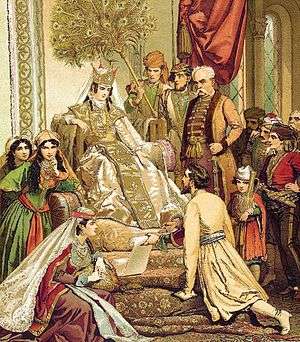
Context and time
The creation of the poem corresponds to the Golden Age of the Kingdom of Georgia and the reign of Queen Tamar who was enthroned by her father King George III of Georgia. Tamar was celebrated by poets for her beauty, intelligence and diplomatic skills. She magnified the Georgian kingdom to its historical maximum extension, repulsed the invasions and established protectorates over many Muslim and Christian lands around. Under her reign, the economy prospered and the Georgian caravans reached Ayyubid Egypt, the Kievan Rus and the Byzantine Empire. Medieval science grew and the largest monasteries and churches in Georgia were built, secular literature developed to the point of equaling the greatest religious texts. It was with the backdrop of this "remarkable growth" that Shota Rustaveli composed his poem.[10] Rustaveli, a Meskhetian from the south-western Georgian town of Rustavi, was close to Queen Tamar and possibly served as her treasurer.[11] He likely participated in many military campaigns and the stories in his poem are set in faraway lands, but allegorical representations of his contemporaneous Georgia are recognizable in his work by many things, such as references to wine culture and a female king who became an heir of her father.[12]
In the very prologue, Rustaveli mentions that he wrote this poem for praising the "King" Tamar.
თამარს ვაქებდეთ მეფესა სისხლისა ცრემლ-დათხეული, |
By shedding tears of blood we praise King T'hamara, |
| —The Knight in the Panther's Skin: Stanza 4 | —Translated by Marjory Scott Wardrop: Stanza 4[13] |
And in the epilogue (given here with a formal paraphrase) he praises the queen's king consort David Soslan.
ქართველთა ღმრთისა დავითის, ვის მზე მსახურებს სარებლად, |
For the goddess whom David the sun serves in his course by all rights, |
| —The Knight in the Panther's Skin: Stanza 1666 | —Translated by Lyn Coffin: Stanza 1658[14] |
Content and form
Title
Georgian title ვეფხისტყაოსანი (vepkhistqaosani) literally means "one with a skin of vepkhi". The identity of the animal that it refers to is not certain and it can be a tiger, panther or leopard. In modern Georgian, it refers to the tiger. However, according to more modern research it would rather mean a panther. Similarly, the qualification of "knight" is not derived from the original title and its alternative translations exist, such as the "valiant" or simply a "man."[15] The alternative English titles of the poem also are "Lord of the Panther Skin"[16] and "The Man in the Panther's Skin".[17]
Story
The story can be divided into two parts: the first part is Avtandil's quest for Tariel, the titular "knight in the panther's skin", and the second part is Avtandil's quest for Nestan-Darejan, Tariel's love.
Search for Tariel
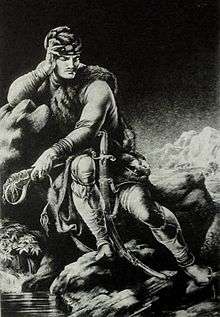
The King of Arabia, Rostevan, has no sons and confers the kingship on his only daughter, the beautiful and wise Tinatin. She has a tender affection for Avtandil, the knight and commander-in-chief of Rostevan's armies. One day, Avtandil challenges King Rostevan to a hunting competition. They have spent three days shooting game when they encounter a knight crying by a river, dressed in a panther's skin, who kills the slaves sent by the king to contact him before disappearing. Rostevan sends parties across the world to search for the mysterious knight, but becomes disheartened when he fails. Tinatin then asks Avtandil to find the strange knight in three years, promising him her hand in marriage in return. After two years and nine months of searching, Avtandil finally finds the knight in the panther's skin hiding in a cave with only a maiden for company. His name is Tariel, son of the king of the seventh kingdom of India, King Saridan. He had served as heir to King Pharsadan, king of the other six kingdoms, for many years when he fell in love with Pharsadan's daughter, Nestan-Darejan. Tariel wages war with the Khatavians to earn the favor of Nestan, but is dismayed to find she has already been promised to the Khwarezmian prince. Tariel could not bear the idea of marriage, and at the request of Nestan he killed the suitor. The princess was then placed on a boat and adrift on the seas. Despite Tariel's lengthy search for his love he could not find her. Later he met Nuradin-Phridon, ruler of Mulgazanzar, who told him that Nestan was alive but trapped on a distant boat. Tariel retired to a cave to live in the wilderness with Asmat, the former servant and messenger of Nestan. Moved by this story, Avtandil promises his friendship and brotherhood to Tariel and agrees to help him find his love, Nestan-Darejan. Avtandil returns home to Arabia, tells Tinatin the story of Tariel and returns to his new friend, going against king Rostevan's will.[18]
Search for Nestan-Darejan
Avtandil then leaves Tariel to go to the kingdom of Phridon, where he does not hear anything new about Nestan. Continuing his quest, he arrives in the city of Gulansharo. He meets Patman, the wife of the chief Usen, who falls in love with him. Avtandil, sensing she knows the fate of Nestan, succumbs to Patman's seduction. She tells him she has been keeping Nestan at her place and, as Nestan was promised to the king's son, she helped her escape, but in her flight Nestan was abducted by Kaji the demon king. Avtandil then returns home to Phridon and to the cave of Tariel and later all three friends decide to go to the country of Kaji with an army of three hundred men to find and deliver Nestan. When she is released, all return to Arabia, where King Rostevan forgives Avtandil his flight and breaking the king's order. They all celebrate the marriage of the latter with the king's only daughter, Tinatin. They then leave for India where Tariel marries his love Nestan. Phridon also returns to his homeland and the three friends reign happily with prosperity and generosity in their own respective realms.[19]
Places and characters
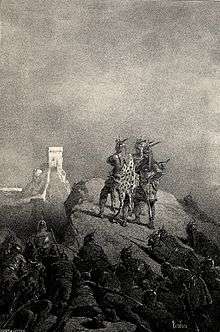
Places
The poem is placed far away from Georgia in countries that the poet has certainly never visited: Arabia, India and "Khataeti" that is to say, China. The indications are vague and not designate any particular site.[20] It is the Georgian kingdom that has existed through these distant lands. It seems that the choice of places refers primarily to the national character of these peoples: the Arabs are portrayed as more rational, as the king Rostevan and his knight Avtandil with their communication skills and action help to break deadlocks. Conversely, the Indians appear to be more emotional and impulsive and cause unintended disasters, as of the image of Tariel and Nestan.[21] Other locations mentioned as the Kajeti or country of Kaj demons are imaginary. Gulansharo, capital of the "Kingdom of the Seas", has been compared to Venice.[22]
Characters
- The brave and loyal knights — Avtandil and Tariel
These two characters represent the most devouted and friend lover characters, both heroes capable of courtly love and men endowed with free will.[23] They initially were actively involved and served the kingdoms held position of modern "steward" or "Mayor of the Palace".[24] Besides their position they only obey their beloved therefore their love and dedication is unwavering. Their mutual commitment friendship they swear, also extends to a third person who is Nuradin-Pridon who is also endowed with the same heroic qualities. Tariel is however distinguished by his wild character as he's attributeed with the panther's skin. The qualities associated with him of animal what is the power, intelligence or passion adds the impression of his feelings, his dedication and courage, as his hatred and violence could be extreme and uncontrollable.[25] It is also close to Saint George slaying the dragon whose cult was particularly strong in the 12th century especially in the episode where Tariel kills a lion and a panther.[26]
- The faithful and patient lovers — Tinatin and Nestan-Darejan
Although they take little action, these female characters, Tinatin and Nestan-Darejan are constantly present in thoughts of the knights and in the narrative tension as a whole. Princesses, a higher rank than their servant knights, they are inspired by the Queen Tamar or reflect the fact that each of them is the sovereign in their own realm.[27] Tinatin chooses her own husband, and it references to Queen Tamar as her role of the king and his father Rostevan, ceding his throne to his daughter references King George III of Georgia who was succeeded by her daughter in 1178, after his death.[28] Tinatin is a static character who leaves no time to the court of his father in Arabia. Nestan being a prisoner in the distant regions, is also passive. But their confidence, righteousness, shows these two women being faithful and respective lovers. As for Patman, she is an altered representation of their type but an infidel during the absence of her husband.[29] Patman takes little account of family honor as she humiliates her husband on account of his bodily defects. Patman's character is true to life from the artistic point of view. Despite everything, she is capable of displaying both affection and sincere warmth peculiar to a woman. She spares no effort to save Nestan. It is very characteristic that when Patman learns of the purpose of Avtandil's journey, she makes no attempt to keep the man she loves at her side even for a short time.[30]
Human relationships
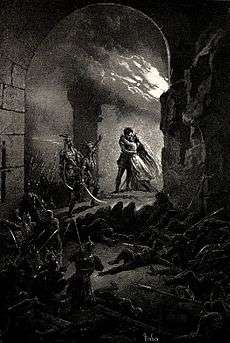
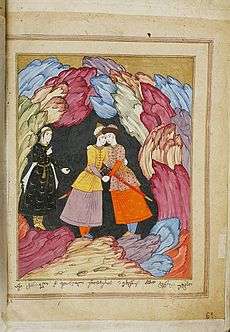
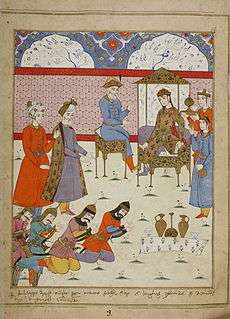
Rustaveli is a great humanist. The poet focuses his attention on a man as a complex of sincere feelings, emotions, passions and aspirations. To counterbalance the mentality of the Middle Ages and the ecclesiastic morality of asceticism Rustaveli's poem proclaims the freedom of man as a personality, freedom of thought and feeling.[31]
Love
In the prologue, Rustaveli describes three types of love: an inaccessible due to the divine, heavenly love; physical love; and finally, a higher earthly love or passionate love.[32] Rustaveli thinks that pure and constant love does not expect love in return.[33] Such kind of love can not be felt without a strong spirit and the only possibility of experiencing love of this order is determined by the natural qualities that should have a real human being. Therefore, the valiant must have its beautiful with impeccable behavior including a constant devotion, the rejection of social duties and selfless loyalty. And as the author puts it "love is a severe trial for man as for woman".[34]
Loyalty of Nestan that fills the work and supports the dramatic tension well before the appearance of the character, is a model of righteousness. When it was announced that she would be married against her own will, she protests with force and supports its consequences with her heroic courage and stoicism. For three heroes who go to her aid, fearless and selfless, the fight is intended as a quest for justice. Amorous conquest is also noticeably absent from the poem. Both romantic relationships are paralleled and never mixed as the true brotherhood between the two heroes prevent such incidents.[35] Love, like friendship, often gives rise to hyperbolic descriptions in the poem.[36]
Friendship
The friendship between the three heroes sworn, Avtandil, Tariel and Pridon, a clear narrative of the entire epic, binds them together and at the same time it binds their peoples. These three men belong to different nations, they find themselves with the same aspirations and the same goal and that is their union of forces that can and will destroy a tyranny and evil what is represented by the Kajs.[37] This friendship, full of honesty and courage, free of cowardice and sycophancy, must go to the death if necessary. Such friendship is also possible between persons of different sexes in this case of Tariel and Asmat who share the same cave in brotherhood. However, love and friendship are intertwined as love of a knight with his heroism is fully realized with the help of a disinterested friendship and absolute loyalty. Both feelings are also expressed in the terms when Avtandil even against the will and order of his king departs to help his friend in need. Moreover, the happiness of each is conditioned by the happiness of others. Tinatin allows Avtandil to leave for Tariel, because it is the duty of her suitor to rescue his friend to whom he has promised to help.[38]
Morals, religion and philosophy
Values
With the glorification of courtly love, Rustaveli leads to strongly condemn forced marriages. Poem also shows an admiration for the woman and demands for gender equality. Even though Queen Tamar is the first female monarch and the sovereign of the kingdom, women's political function, position and leading role in Georgia was very high be it the patronage of Georgia by the Virgin Mary or conversion of Georgians to Christianity by a woman, Saint Nino in the 4th century.[39] This "cult of woman"[40] celebrates her honor and freedom to choose her own husband and Nestan is the model of a noble woman who puts reason above passion. In equal rights, women can develop a sincere friendship with the opposite sex without love and desire and Asmat is dedicated to Tariel. Slavery is also condemned in the poem.[41]
Politically, the poem does not lack and is not without patriotism. The state must be led by a strong and autocratic central government, however, sovereigns must rule with justice and prudence.[42]
In general, the poem is a "manifest of living with joy". The success of the three heroes in the liberation of Nestan shows that justice can exist on earth, as with enough courage and perseverance, one can find the happiness here.[43]
Religious and philosophical views
The poem sometimes gives the impression of being a pagan work.[44] In fact, there are no prayers in the poem, and no references to Christ, the Virgin Mary, or the Trinity. However, Paul the Apostle is mentioned, and there are a number of references to the Gospels and the Old Testament, including ten occurrences of the Garden of Eden, as well as references to the Euphrates, Gibeon and Levi).[45]
Nevertheless, the moral framework of the work is Christian, with a clear dichotomy between a good god and a hard and disappointing world. This Christianity is not, however, fanatical. Rustaveli refers to the Quran multiple times to indicate that most of the characters are Muslim. He never offends Islam in his work and uses it as an allegory for Christianity, since most of the values that the poem promotes are of Christian origin. He also mentions the twelve apostles (verse 799) and how they spread the philosophy of benevolence and love.
There are philosophical references in the poem to the work of Pseudo-Dionysius (verse 1478) which may be attributed to the influence of the Georgian monk Peter the Iberian, an idealist, who believed in the oneness of God but sees the impossibility of knowing God's real existence.[46] Rustaveli's presentation of God as a universal force rather than a Christian one once led to the suppression of the poem. Believing Rustaveli was a Muslim, the Georgian Orthodox Church in the past destroyed copies of the poem.[47]
Translations
Within Georgia, the poem has been translated into other Kartvelian languages like Laz, Svan and Mingrelian languages.
Outside of Georgia, interest in the poem first appeared in 1802, when Eugene Bolkhovitinov published a verbatim translation of the first stanza of the poem into Russian.[48] In France in 1828, Marie-Félicité Brosset made his first partial French translation.[49] In the 19th century the poem saw full translations into Polish,[50] German[51] and Russian. In 1845, extracts were published in Russian, French and Armenian. Vahan Terian, a prominent Georgian-born Armenian poet, translated the prelude, which was first published posthumously in 1922. It was praised by Nicholas Marr.[52][53] In 1912, Marjory Wardrop published the first English translation available.[54] In 1968, a verse translation by Venera Urushadze was published in Georgia. In 2015, an English poetic translation by Lyn Coffin was published, combining literary achievement with academic precision.
Today, unabridged editions are available in many languages: Abkhaz,[55] Armenian,[56] Azerbaijanian,[57] Bashkir, Belarusian,[58] Bulgarian, Chechen,[59] Chinese,[60] Chuvash, Czech,[61] Esperanto,[62] Greek, Hebrew,[63] Hungarian,[64] Italian,[65] Japanese,[66] Kazakh,[67] Korean, Kurdish,[68] Kyrgyz,[69] Moldovan,[70] Mongolian,[71] Ossetian,[72] Persian, Romanian,[73] Serbian, Spanish,[74] Tatar, Turkmen,[75] Ukrainian,[76] and Uzbek.[77]
Among the translations, the 1989 Esperanto version by Zurab Makaŝvili[78] and the 2015 English version by Lyn Coffin are notable not only for faithfully reproducing the content of the poem, but also for preserving the poetic structure of the epic in shairi (rhymed stanzas of four sixteen-syllable lines).
References
- Baramidze & Gamezardashvili, p. 17
- Shengelia, p. 106
- Shengelia, p. 105
- Delshad, p. 18
- Baramidze & Gamezardashvili, p. 19
- David Marshall Lang. Landmarks in Georgian Literature. School of Oriental and African Studies, 1966, p. 20
- Asatiani & Bendianashvili, p. 151
- Malinka Velinova, "Interférence des genres dans les emplois du monologue médiéval", Institut Roustavéli, p. 160
- Polet, p. 529
- Polet, p. 500
- Polet, p. 525
- Kveselava, p. 13
- Wardrop, p. 1. Wardrop's prose translation is here lineated as verse.
- Rustaveli 2015, p. 345
- Orbeliani & Iordanishvili, 1949
- Rustaveli, SUNY Press, 1977
- Rustaveli, Netlancers Inc, 2014
- The Knight in the Panther's Skin, III-XXX
- The Knight in the Panther's Skin, XXX-XLV
- Beynen, p. 221
- Beynen, p. 219
- Beynen, p. 222
- Beynen, p. 228
- Delshad, p. 50
- Polet, p. 548
- Mirianaschwili, Müller & Müller, «Schota Rustaveli, "Der Ritter im Tigerfell", 1999
- Wardrop, p. 6
- Beynen, p. 220
- Wardrop, p. 7
- Baramidze & Gamezardashvili, p. 25
- Baramidze & Gamezardashvili, pp. 25-26
- Baramidze & Gamezardashvili, p. 21
- Wardrop, p. 4
- Baramidze & Gamezardashvili, pp. 21-22
- Beynen, p. 232
- Wardrop, p. 7
- Baramidze & Gamezardashvili, p. 23
- Polet, p. 527
- Shengelia, p. 107
- Baramidze & Gamezardashvili, p. 22
- Khakhanoff, p. 95
- Baramidze & Gamezardashvili, p. 24
- Baramidze & Gamezardashvili, p. 20
- Rayfield, p. 77
- Wardrop, p. 270
- Rayfield, pp. 77-78
- Nasmyth, Peter (1998). Georgia in the mountains of poetry. Palgrave Macmillan. p. 82. ISBN 978-1-349-61941-2.
- Bolkhovitinov, Историческое изображение Грузии в политическом, церковном и учебном ее состаянии, St. Petersburg, 1802
- Brosset, pp. 277-294
- Lapchinski & Eristavi, 1840
- Der Mann in Tigerfelle, von Schota Rustaveli, Arthur Leist, 1889 online version
- Asatur, Georg (1966). Շոթա Ռուսթավելի Ընձենավորը [Shota Rustaveli "The Knight in the Panther's Skin"] (in Armenian). Yerevan: Armenian Academy of Sciences Publishing. pp. _Shota_Rustaveli.djvu 253-256.
- Bakhchinyan, Henrik (8 March 2018). "Չարենց և Ռուսթավելի [Charents and Rustaveli]". Azg (in Armenian).
- Taktakishvili & Urushadze, pp. 142-148
- Gulia, Sokhumi, 1941
- Asatur, Yerevan, 1937
- Vurghun, Rahim & Rustam, Baku, 1937
- Zvonak & Khvedarovitch, Minsk, 1966
- Mouzaev, Grozny, 1969
- Li-tsi-e, Shanghai, 1943
- Státní nakladatelství krásné literatury, hudby a umění, Praha, 1958
- Baramidze, p. 344
- Shalom Barel,2017
- Tsereteli, pp. 661-664
- La pelle di Leopardo di Schotha Rusthaveli, Milan, 1945
- Kotchlashvili & Fukuro, 1962
- Almaty, 1938
- Asad & Ankus, 2007
- Frunse, 1956
- Krecu, Chișinău, 1966
- Gombojav, Ulan-Bator, 1965
- Shavlokhovisa, Tskhinvali, 1943
- Vera Roman, Bucarest, 1947
- Gustavo de la Tore Botaro, Santiago, 1964
- Ashgabat, 1957
- Mikola Bajan, Kiev, 1937
- Shahzoda 1938 & Mirtemir 1959
- Zurab Makaŝvili: Kavaliro en tigra felo, Tbiliso 1989
Sources
| Wikimedia Commons has media related to The Knight in the Panther's Skin. |
- Nodar Asatiani & Alexandre Bendianashvili, Histoire de la Géorgie, Paris, l'Harmattan, 1997
- A. G. Baramidze & D. M. Gamezardashvili, Georgian Literature, Honolulu, University Press of the Pacific, 2001 (1st ed. 1968)
- Gijs Koolemans Beynen, "Adultery and Death in Shota Rustaveli's The Man in the Panther Skin", Courtly Arts and the Arts of Courtliness, 2004
- Farshid Delshad, Studien zu den iranischen und semitischen Lehnwörtern im georgischen Nationalepos "Der Recke im Pantherfell", Iéna, 2002
- A. Khakhanoff, Abrégé de l'histoire et de la littérature géorgienne, dans Raphaël Isarloff, Histoire de Géorgie, Paris - Tbilissi, Charles Noblet - Librairie de la société géorgienne de lettres, 1900
- M. Kveselava, Anthology of Georgian Poetry, Honolulu, University Press of the Pacific, 2001 (1st ed. 1948)
- Jean-Claude Polet, Patrimoine littéraire européen, vol. 4a, Le Moyen Âge, de l'Oural à l'Atlantique. Littératures d'Europe orientale, De Boeck, 1993
- Donald Rayfield, The Literature of Georgia, Richmond, Curzon Press, 2000 (1st ed. 1994)
- Shota Rustaveli The Knight in the Panther Skin, new translation by Lyn Coffin. Poezia Press, 2015 Tbilisi, Georgia
- Kakha Shengelia, History of Georgia, Tbilisi, Caucasus University Publishing House, 2001
- Marjory Scott Wardrop, The Man in the Panther's Skin: A Romantic Epic by Shota Rustaveli, Royal Asiatic Society, 1912
- Beynen, G. Koolemans. "Murder, Foul and Fair, in Shota Rustaveli's The Man in the Panther Skin," in Medieval and Early Modern Murder, Larissa Tracy, ed. (Woodbridge: The Boydell Press, 2018), pp. 350-70.